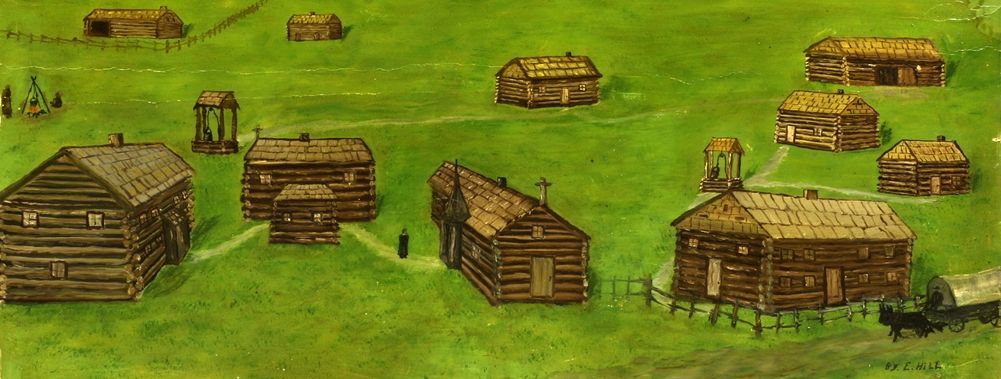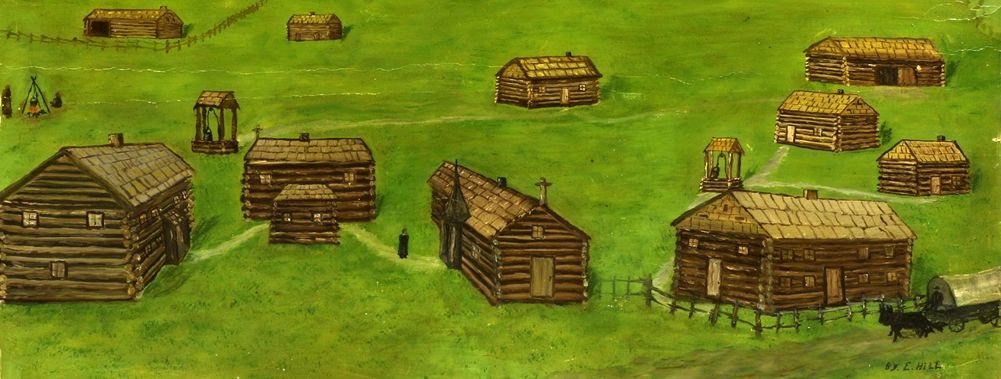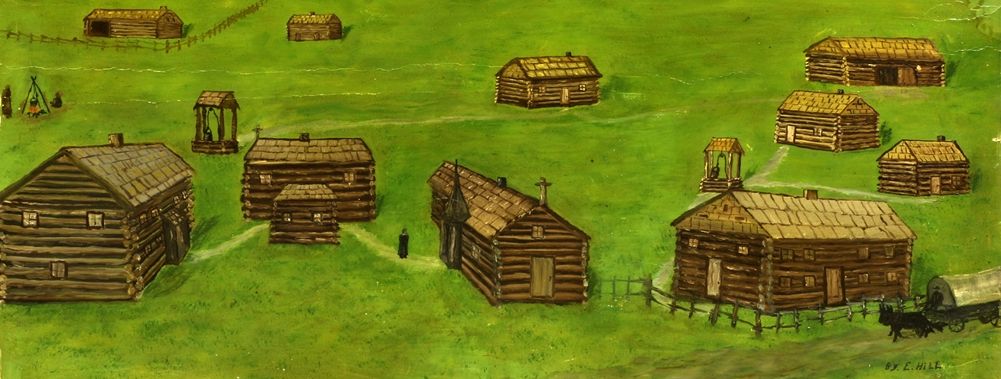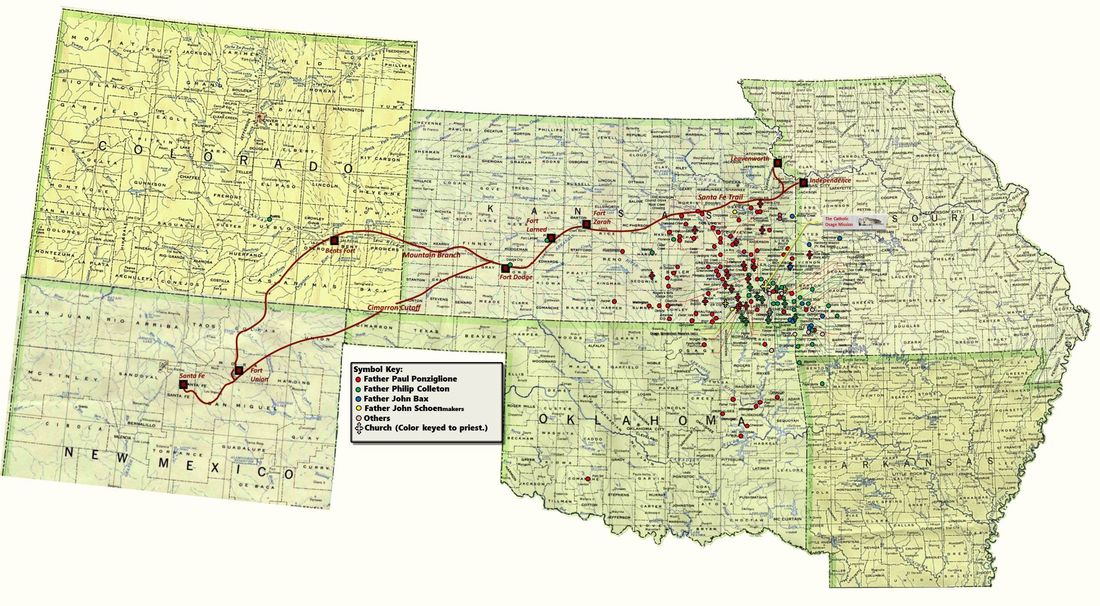|
On April 28, 1847, one of the longest, continuous-running stories in Kansas history got its start in Neosho County. Political wrangling and planning started a few years earlier; but when the Osage Mission opened, in April of 1847, it had a substantial effect on the future of of the Osage People, education, religion, commerce, and the settlement of southern Kansas and the four-state region. The story continues. On April 28, 1847, several ox-drawn carts lumbered into the grounds of a newly constructed mission-yard. Five weary men climbed down from the carts and were quickly surrounded by an enthusiastic group of Osage who had come to greet the Tapuska-Watanka (priest lords). The missionaries included Mission Director, Father John Schoenmakers; his young assistant Father John Bax; and three coadjutor brothers: John Sheehan, John De Bruyn and Thomas Coglan (Brother Thomas O’Donnell joined them in 1848). All of the missionaries had already immigrated to a new land when they came to America, and the Mission site might have seemed alien. Father Bax’s impression of their arrival was embodied in a letter to Father Pierre Jean De Smet: "It would be impossible to paint for you the enthusiasm with which we were received … At first sight of these savages … I could not suppress the pain I felt … The adults had only a slight covering over the middle of the body; the little children, even as old as six or seven years, were wholly destitute of clothing. Half serious, half jesting, I thought that a truly savage portion of the Lord’s vineyard had been given to me to cultivate.” These men were the first missionaries to staff the government's Osage Mission Indian boy's school. A group of four Loretto Sisters opened the girl's school the following October. More Jesuits and Lorettos would follow. The mission was so remote and foreboding that government contractors rushed through construction of the mission buildings so they could return to civilization. As a result the missionaries dealt with leaks, a fireplace chimney collapse and structural problems for years. But the schools thrived, as best as they could, with inadequate funding; and through famine, epidemics, floods, a War and deaths. Through it's trials, the missionaries witnessed the birth of civilization in southern Kansas. They watched barren prairies transform into a landscape of homesteads and small towns and the Jesuits assisted with the founding of several settlements. With Osage Mission serving as the Jesuit missionary headquarters, south of the Santa Fe Trail, they established more than 150 mission stations in Kansas, Missouri, Oklahoma, Arkansas and Colorado. When the Osage land cessions occurred during the 1865 - 1870 period, the Jesuits and Lorettos had a plan and the means to execute it. As part of the Osage land cession treaties, Father Schoenmakers was gifted a section of land by the Osages, and options to buy more, which he did. When he founded the town of Osage Mission, he already had a church, schools and a well trained staff of school teachers and administrators. Beginning with the establishment of his town company, Father Schoenmakers undertook the work of transitioning the Indian schools into public schools and he and Sister Bridget Hayden built two prestigious frontier boarding colleges. The mission and it's schools eventually evolved into a very unique new town and the schools we enjoy today. The schools on the lots west of the present St. Francis Catholic Church have provided continuous, quality education for 173 years — They have never missed a term! The following link from the St. Francis Catholic Church website is an abridged version of the Osage Mission Story:For the entire 15 chapter Osage Mission story,follow THIS LINK. [1] Some Reference Information:
1. The Saint Francis Catholic Church history page does not include Chapter 14 of the A Catholic Mission "Our Story" page (The Anti-Horse Thief Association). Southern Kansas and the Four-State Region Began to Change That Day. On April 28, 1847, several ox-drawn carts lumbered into the grounds of a newly constructed mission-yard. Five weary men climbed down from the carts and were quickly surrounded by an enthusiastic group of Osage who had come to greet the Tapuska-Watanka (priest lords). The missionaries included Father John Schoenmakers; his young assistant Father John Bax; and three coadjutor brothers: John Sheehan, John De Bruyn and Thomas Coglan (Brother Thomas O’Donnell joined them in 1848). All of the missionaries had already immigrated to a new land when they came to America, but the Mission site might have seemed alien. Father Bax’s impression of their arrival was embodied in a letter to Father Pierre Jean De Smet: “It would be impossible to paint for you the enthusiasm with which we were received … At first sight of these savages … I could not suppress the pain I felt … The adults had only a slight covering over the middle of the body; the little children, even as old as six or seven years, were wholly destitute of clothing. Half serious, half jesting, I thought that a truly savage portion of the Lord’s vineyard had been given to me to cultivate.” These men were the first missionaries to staff the government's Osage Mission Indian boy's school. A group of four Loretto Sisters opened the girl's school the following October. More would follow. The mission was so remote and foreboding that government contractors rushed through construction of the mission buildings so they could return to civilization. As a result the missionaries dealt with leaks, a fireplace chimney collapse and structural problems for years. But the schools thrived, as best as they could, with inadequate funding; and through famine, epidemics, a Civil War and deaths. Through it's trials, the missionaries witnessed the birth of civilization in southern Kansas. They watched barren prairies transform into a landscape of homesteads and small towns and the Jesuits assisted with the founding of several settlements. With Osage Mission serving as the Catholic missionary headquarters, south of the Santa Fe Trail, they established more than 150 mission stations in Kansas, Missouri, Oklahoma, Arkansas and Colorado. The mission and it's schools eventually evolved into the town and schools we enjoy today. The schools on the lots west of the present St. Francis Catholic Church have provided continuous, quality education for 172 years — They have never missed a term! The following link from the St. Francis Catholic Church website is an abridged version of the Osage Mission Story: For the entire 15 chapter Osage Mission story, follow THIS LINK. [1] Some Reference Information:
1. The Saint Francis Catholic Church history page does not include Chapter 14 of the A Catholic Mission "Our Story" page (The Anti-Horse Thief Association). On April 28, 1847, a small procession of ox-drawn wagons rolled onto the grounds of a newly built mission schools campus. The location was a remote eminence one mile north of the juncture of Flat Rock Creek with the Neosho River in present Neosho County, Kansas [2]. Five weary men climbed down from the carts and were quickly surrounded by an enthusiastic group of Osage who had come to greet the Tapuska-Watanka (priest lords). The wagons carried furniture, equipment and supplies to start the new mission and sustain it for a few months.  Father John Schoenmakers Father John Schoenmakers The men were Jesuit Missionaries Father John Schoenmakers, his young assistant Father John Bax and three coadjutor brothers: John Sheehan, John De Bruyn and Thomas Coglan (Brother Thomas O’Donnell joined them in 1848). All of the men were immigrants to the United States. All would spend the rest of their lives here. One of them, Father Bax, lived slightly more than five years after his arrival. He might have worked himself to death trying to help his beloved Osage through the Black Measles epidemic of the early 50's. All of the founding Jesuits are buried in St. Francis Cemetery just one-quarter mile east of the mission site.[3] The Catholic Osage Mission served two purposes. It was an Osage Indian school operated by the Jesuits, with the Sisters of Loretto, under contract with the United States Government. It also served as the Jesuit headquarters for missionary activity south of the Santa Fe Trail. 1. Was the Mission Successful? From the following, you can certainly sense frustration expressed by an Italian nobleman turned missionary. "It is difficult at this Mission among the Osage to write annual letters for there are but few things worthy of notice. From the very beginning of this mission in 1847 to the present very little was accomplished among the aborigines and there is little hope of accomplishing anything in the future." There were reasons to be discouraged — and many reasons to be proud. 1. The Osage Mission and Schools: In spite of constant funding issues, the mission school was successful. The Jesuits and Lorettos found the young Osage to be smart, attentive and enthusiastic students. In fact, some Osage Mission students and their offspring did well in later life. Conversion to Catholicism met with mixed success. Among the half-breed Osage were some French Canadians who had been baptized young and showed cooperation with the priests — but many of them knew little about the faith. Some of the full-blood Osage were religious and, when treated fairly, were submissive to authority and the teachings of the church. But the mission's main drawback was time. Given the twenty-three year lifespan of the mission, early language barriers, constant funding issues, and the nomadic nature of the flock, there was not enough time to fully influence a people who already had deep religious beliefs. Today, many Osage embrace a strong Catholic faith that is blended with their early religious culture. 2. Jesuit Missionary Work: As a missionary headquarters, the mission was very successful. In fact, the Osage Mission Jesuits played an important part in the settlement of southern Kansas, southwest Missouri, northwest Arkansas and northern Oklahoma. In addition to spreading and nurturing their faith; the missionary priests gave several fledgling settlements an important component for growth — a church. In some cases they also started schools. To date we have accounted for more than 150 mission stations in the four states listed above and Father Philip Colleton traveled as far as Pueblo, Colorado. Some stations were temporary but many evolved into churches. Father Paul Ponziglione said the first Mass in Wichita at a location only blocks from the Cathedral of the Immaculate Conception. As part of his missionary work, Father Schoenmakers served as a counselor to the Osage in matters of legal and government affairs as well as spiritual needs. In this capacity, Father John's word was often final. His influence with the Osage and the government played an important part in the settlement of treaty disputes among the government, the Osage and the settlers. His intervention into the controversial Sturgis Treaty negotiations likely prevented a serious disservice to the tribe, the southern Kansas settlers and the state of Kansas. Overall, the mission and it's missionaries left a pretty important mark on the Osage people and the state of Kansas. Some Reference Information.
|
Thoughts 'n ThingsSome 'Thoughts' and short articles about past and present-day St. Paul and the Southern Kansas - 4 State Region. Archives
December 2023
Categories
All
|
- Home
-
Our Story
- 1. The Stage is Set
- 2. The Osages Enter Kansas.
- 3. Earliest Commerce
- 4. Earliest Protestant Missions
- 5. The Catholic Osage Mission >
- 6. Progress and Tragedy
- 7. The Missionary Trails >
- 8. A Dangerous Balance - The Civil War >
- 9. The Osage Leave Kansas >
- 10. A Very Unique Community is Born >
- 11. Regional Boarding Schools >
- 12. Transitions
- 13. The Passionists Era Begins
- 14. Citizen Lawmen - The A.H.T.A. >
- 15. The Passionist Influence is Expanded
- 16. The Schools Today >
-
Characters
- The Osages
-
The Missionaries
>
- Father John Schoenmakers >
- Fr. John Bax >
- Mother Bridget Hayden
-
Fr. Paul Ponziglione
>
-
Father Paul's Memoir
>
-
Index - Father Paul's Memoir
>
- Dedication & Introduction
- IX. Construction & Acceptance of Mission Buildings.
- X. Fr. Schoenmakers Arrives at Osage Mission
- XI. Miss Lucille St. Pierre Came to the Neosho
- XII. Progress of the Schools
- XIII. Origin and Development of the Roman Catholic Church in Kansas
- XXVII - Winds of War
- XXVIII — Fr. Schoenmakers Return
- Chapter XLII - Farming Issues, Death Of Father Colleton
- Chapter XLIX - Includes The Death of Fr. Schoenmakers
- Chapter L — Dedication of the New Church
- Conclusion
- Appendix I — Copy of a letter to Sister M. Coaina Mongrain about the coming of the Sisters of Loretto at Osage Mission
- Appendix 6 — A Sketch of my Biography
- Appendix 7 - Letter to W. W. Graves
-
Index - Father Paul's Memoir
>
-
Father Paul's Memoir
>
- Father Philip Colleton
- Brother John Sheehan
- W. W. Graves
- 17 Sisters
- 17 Sisters II - Fr. Fox's Sermon
-
Who's Behind the Window
>
- Who We Were 120 Years Ago
- 1. The Thomas Carroll Window
- 2. The W.W. O'Bryan Window
- 3. The Jas. Owens & Family Window
- 4. The C.P & C.J. Hentzen Windows
- 5. The Dr. McNamara & Family Window
- 6. The Fitzsimmons & Family Window
- 7. The Parents of T.K. Joyce Window
- 8. J.E. Sevart & Family Window
- 9. The Rev. John Schoenmakers S.J. Window
- 10. The Patrick Diskin and L&M George Window
- 11. The J.A. Johnston & Family Window
- 12. The Peter & Jacob Bonifas Windows
- 13. The Mr & Mrs. Patrick Keeting Window
- 14. The John Butler Window
- 15. The Mr. & Mrs. Gutting Window
- 16. Rosette Window Above Doors
- 17. The Michael A. Barnes Window
- 18. The Henry M. O'Bryan Window
- 19. The John and Bridget McCarthy Window
- The Sodality Windows
- The Church Women's Bonfire (Graves)
- Beechwood
- John and Margaret Naudier
- Fr. Tom McKernan - The Poet Priest of Kansas
- The Dimond Family and Estate Sale
- Dear Sister >
- A Year and a Day — Passionist Memories.
- Mary Elizabeth Lease
- K of C Council 760 - The Early Days
- Our Hometown Boys
- SPHS Class of 1956
-
Places
- The Great American Desert
- St. Francis Catholic Church
- St. Francis de Heironymo Catholic Church Grounds
- St. Paul - 135 Years Ago
- St. Paul - 1890's as a Scale Model.
- St. Paul - The Booming 60's
- Osage Mission as a Statewide History Finalist
- St. Francis Cemetery
- Hope Cemetery
- The Basement Chapel
- World War I Museum Display
- St. Paul Middle School >
- Ladore
- St. Boniface, Scipio KS
- Road Trip - Father Emil Kapaun
- Exchange State Bank Robbery!
- Thoughts ...
- Links
- Link Page
Thoughts 'n Things
Past and Present Day St. Paul, Southern Kansas and The Four - State Region.

|
acatholicmission.org is a privately hosted website. We hope that our site will educate and entertain those who are interested in the fascinating Osage Mission - St. Paul - Neosho County Kansas story. Ours is a regional story that crosses state lines, ethnic groups, faiths and a variety of frontier and post-frontier interests. Enjoy.
acatholicmission.org Copyright © 2016 - 2024. All rights reserved. (See copyright note on Contact page.) |






 RSS Feed
RSS Feed